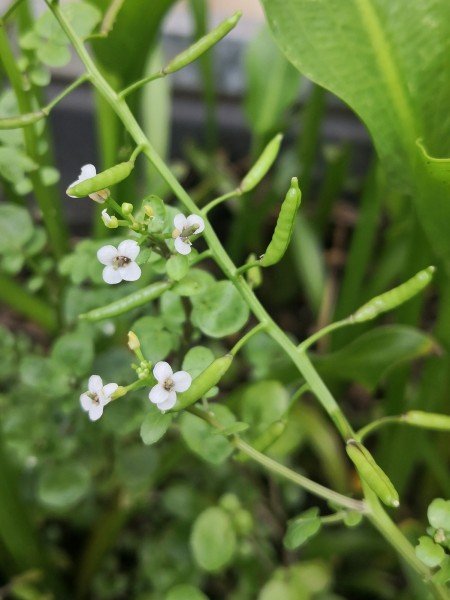Hi Herbal Hiveans. Here's the next in my new series of posts covering how to use the herbs in our garden. You can find the earlier ones by wandering back through my blog. Once I've quite a few, I'll make an index page for them for your ease of use. This installment is about Watercress.

Common names: Watercress
Taxonomic name: Nasturtium officinale
Family: Brassicaceae
Uses: Food, general immune system booster, colds and flu, antiseptic, digestive and expectorant, skin.
Area of origin: Europe and Asia
Warnings: can have quite a bite!
Watercress (Nasturtium officinale) isn’t to be confused with the garden Nasturtium (Tropaeolum majus) even though its Genus name is the same as the latter’s common name. This is just a bit of confusion but it’s due to the fact that both have quite a mustardy bite. ‘Nasturtium’ comes from Latin in which it means \literally ‘to twist the nose’. Both plants are related, being in the Cabbage Family, Brassicaceae.
Watercress is highly nutritious and is especially high in vitamins A, C and K. One cup of Watercress has 106% of the recommended daily intake of Vitamin K. Many of the nutrients packed into it are powerful antioxidants which reduce the chance of several types of cancer, diabetes and heart disease.
The antioxidants and vitamin K are enormously beneficial for clotting and the health of blood vessels. Watercress is also found to lower cholesterol. It is full of minerals too, especially those which contribute to bone health. Nearly everything about this plant contributes to a much healthier and responsive immune system.

Herbally, Watercress is useful when it comes to boosting our immune system. As mentioned above, it is quite a tonic as well as containing compounds which directly fight colds and flu. It should be eaten, fresh in any case of illness where improved digestion can be of assistance (and that’s pretty well anything)!
Like many other Brassicas, Watercress is high in Sulphur.which helps in protein absorption and cell building, especially skin cells.
Watercress can be quite invasive in the garden. Once it’s set seed, you’ll find it popping up everywhere. That’s not such a bad thing, though, as it is so useful.
It is a sprawling plant with hollow stems that allow it to float. It has lobed leaves and green and yellow clusters of flowers. The main way to make sure that you have Watercress is by its bite if you nibble on a leaf.
Making a tea from this herb
To make tea, simply place a teaspoonful or two of dried or fresh herb into a cup of hot water. Cover the cup while the brew steeps so that you don't lose any of those precious oils.






